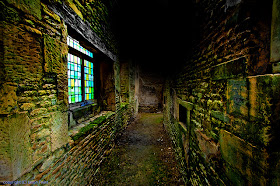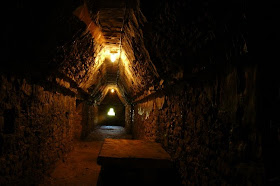 |
| This could be a dungeon hallway |
 |
| Another Narrow Hallway |
eliminating a lot of the fun of exploration. Additionally, in classic exploration scenarios, where random encounters provide a major challenge, the environment - lighting, odors, wall material and most importantly door material, actually effect play. Slick floors may impede melee, low ceilings ranged attacks, weak walls provide ambush opportunities, and strong doors facilitate retreat.
 |
| More classic dungeon hallway perhaps? |
Torn between wanted to avoid excessive description, and wanting to provide evocative spaces for exploration that make it easier to visualize the adventure in a cinematic fashion, I've adopted a few simple tables for the Apollyon that I use to describe spaces when the party blunders off my maps or into sketchily detailed areas. For example, I have a D6 table for what infests the area (1- Vermin, 2- Horrors, 3 - Undead, 4- Devils, 5- Robots, 6- Humanoids) so random encounters and room uses make sense. Better though is the following wall description table, there's another for doors (but it includes some traps and lock mechanisms so I am hiding it for now). What's key about the wall table is that it fits with my setting, and I think I'd have to write a few different ones for various areas of the ship (cabins, industrial areas or crew areas for example), but the one below works generally. For me this is a good investment of time, and I think similar tables would be a good investment in a published megadungeon setting.
|
D20
|
Wall Material
|
Additional details
|
|
1
|
Metal Panels, painted to resemble wood
|
Water damaged, salt stained
|
|
2
|
Thin wood veneer
|
Water logged
|
|
3
|
Lathe and plaster
|
Sooty, burnt
|
|
4
|
Painted metal
|
Ornate moldings and plaster decorations
|
|
5
|
Heavy wooden beams and boards
|
Hastily patched or repaired
|
|
6
|
Ceramic tiles over metal
|
Scrubbed clean
|
|
7
|
Metal panels
|
Scratched and gouged
|
|
8
|
Riveted metal
|
Covered in lichens or fungus
|
|
9
|
Heavy Cast metal
|
Marked with arrows, murals or signage
|
|
10
|
Plastered
|
Gnawed by vermin
|
|
11
|
Wall papered
|
Graffiti covered
|
|
12
|
Velvet or silk wallpaper
|
Rusted or dry rotted
|
|
13
|
Cast ceramic molded over metal
|
With bolt holes for missing furnishings or machinery
|
|
14
|
Covered in peeling wall paper
|
Pasted with handbills
|
|
15
|
Encrusted in filth too deep to know
|
Engraved or cast with relief
|
|
16
|
Metal with marble tile
|
Peeling paint
|
|
17
|
Leather upholstered
|
Odd crystal growths
|
|
18
|
Sheet Rock over metal beams
|
Portholes and armored glass panels
|
|
19
|
Riveted metal
|
Filigree work
|
|
20
|
Metal panels
|
Slicked with oil
|

No comments:
Post a Comment